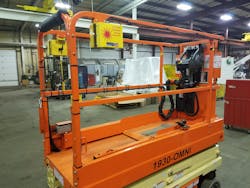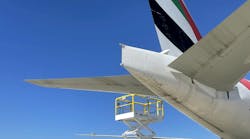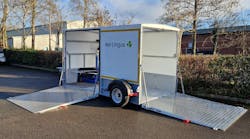Damage to aircraft caused by ground support equipment and other maintenance vehicles is costly. Plus, when there is a collision, it may mean the equipment operator is in harm’s way.
With that in mind, Bailey Specialty Cranes & Aerials has developed collision avoidance systems that can be installed on maintenance platforms.
“We have it on scissors. We have it on boom lifts – anything from a 40- to a 125-foot boom lift – to protect the basket and protect the operator,” says Jeff Bailey, the company’s president and CEO.
Bailey’s collision avoidance kits have been available for two years, and they area stark improvement over other safety systems that utilize padded bumper systems.
“Existing systems have bars, and different things, that after the operator is hit, it’s going to push him into this bar and the bar shuts the machine off,” explains Bailey. “It’s something, more than nothing.”
Rather, his company has worked with manufacturers like JLG, Genie and SkyJack to develop collision avoidance technology for a number of different scissor lifts.
Primarily, the company’s anti-collision kits are made up of two to four sensors as well as an override switch.
“They’re laser scanners. That’s the core technology,” says Bailey.
The lasers project a plane, which is programmed graphically with computer software to suit a customer’s parameters. When an object enters that predetermined plane, the laser recognizes it and sends a signal to the vehicle and operator.
“These sensors go into a little controller. The controller then turns the buzzer on, switches the machine into slow speed, etc.,” says Bailey. “We can have multiple zones. You can have it so that in Zone 1, the lift starts slowing down, and it slows down more when it gets a little closer. Then when it gets too close, it comes to a stop.”
Sticking with this example, if the scissor lift comes too close to the aircraft and stops completely, the operator can use the override switch to turn the machine back on and safely drive away.
Bailey’s collision avoidance systems can use laser technology or radar detection to sense objects.
“They have different purposes,” Bailey points out. “The laser scanner puts out a plane and that plane can be adjusted. Dimensionally, you can fix whatever size of platform or shape you want to have. It’s really clean and easy to program that, and you can do multiple planes with the laser.
“The other technology, radar, shoots out a cone. It has better feedback on exactly how far things are away,” he continues. “But it only gives you an area of a cone, where the laser gives you a big broader area.”
Bailey says both technologies – which are comparable in cost – have their advantages, noting ideally the most accurate system would utilize a combination of both.
This technology can help satisfy the upcoming requirements stipulated by the American National Standards Institute (ANSI) for maintenance lifts.
ANSI Standard A92.6 for scissors lifts and A92.5 for boom lifts will require some form of protection for the operator of this equipment.
Bailey’s laser technology can be programmed to create safety zones around the operator.
“This would protect the operator’s head – stop motion before he’s hit,” Bailey notes.
It also can reduce damage to aircraft, many of which are made of carbon fiber that can be difficult to visually spot damage. Eschewing collisions altogether lessens associated costs and decreases liability.
Bailey Specialty Cranes & Aerials provides other enhanced safety features for lifts, including omni-directional steering to provide improved maneuverability around objects like aircraft. What’s more, pothole protection senses changes in terrain to avoid tipping the lift.
“We have added our Safety Scissor. It’s just a little sensor right in front of all four wheels. It’s checking for a significant change in the ground profile. We monitor that, and if there is a change, it stops the machine before you drive in the hole,” says Bailey.
This can also be useful when large cords are laying on the maintenance floor, he adds, explaining the cords can upset a scissor lift trying to drive over it.
Bailey says the biggest challenge regarding adoption of anti-collision technology, like the sensors his company produces, is getting the price point low enough to interest the industrial market.
“We’re testing and tuning lower cost systems,” he says. “It’s an evolving technology and an emerging technology that’s just going to get better.”
With that in mind, Bailey believes different safety packages can be created to suit different customers – in terms of both cost and need.




